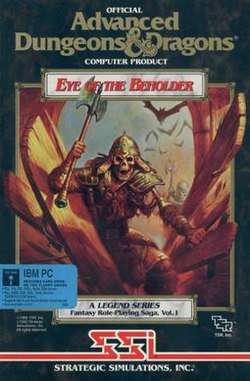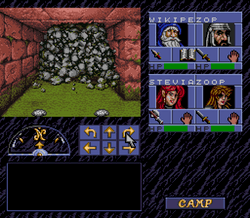Eye of the Beholder (video game)
| Eye of the Beholder | |
|---|---|
 DOS cover art | |
| Developer(s) | Westwood Associates |
| Publisher(s) |
Strategic Simulations, Inc. Capcom (SNES) Sega (Sega CD) Pony Canyon, Inc. (PC-98) |
| Composer(s) |
PC-98 Yuzo Koshiro Sega CD Yuzo Koshiro Motohiro Kawashima Amiga Paul S. Mudra SNES Tatsuya Nishimura |
| Series | Eye of the Beholder |
| Platform(s) | DOS, Amiga, Sega CD, SNES, PC-98 |
| Release |
1991 (DOS) 1991 (Amiga) 1992 (PC-98) April 1994 (SNES)[1] 1994 (Sega CD) |
| Genre(s) | Role-playing video game |
| Mode(s) | Single-player |
Eye of the Beholder is a role-playing video game for personal computers and video game consoles developed by Westwood Associates. It was published by Strategic Simulations, Inc. in 1991[2][3] for the DOS operating system and later ported to the Amiga, the Sega CD, Game Boy Advance and the SNES. The Sega CD version features a soundtrack composed by Yuzo Koshiro.[4] A port to the Atari Lynx handheld was developed by NuFX in 1993, but was not released.
The game has two sequels, Eye of the Beholder II: The Legend of Darkmoon, released in 1991, and Eye of the Beholder III: Assault on Myth Drannor, released in 1993. The third game, however, was not developed by Westwood, who had been acquired by Virgin Interactive in 1992 and created the Lands of Lore series instead.
Plot
The lords of the city of Waterdeep hire a team of adventurers to investigate an evil coming from beneath the city. The adventurers enter the city's sewer, but the entrance gets blocked by a collapse caused by Xanathar, the eponymous beholder. The team descends further beneath the city, going through Dwarf and Drow clans, to Xanathar's lair, where the final confrontation takes place.
Once the eponymous beholder is killed, the player would be treated to a small blue window describing that the beholder was killed and that the adventurers returned to the surface where they were treated as heroes. Nothing else was mentioned in the ending and there were no accompanying graphics. This was changed in the later released Amiga version, which featured an animated ending.
Gameplay

Eye of the Beholder featured a first-person perspective in a three-dimensional dungeon,[5] very similar to the earlier Dungeon Master.[6] The player controls four characters, initially, using a point-and-click interface to fight monsters.[5] This can be increased to a maximum of six characters, by resurrecting one or more skeletons from dead non-player characters (NPC), or finding NPCs that are found throughout the dungeons.
The possibility to increase the size of the player's party through the recruiting of NPCs was a tradition in all of the Eye of the Beholder series. It was also possible to import a party from Eye of the Beholder into The Legend of Darkmoon or from The Legend of Darkmoon into Assault on Myth Drannor; thus, a player could play through all three games with the same party.
Reception
Critical reception
| Reception | ||||||||||
|---|---|---|---|---|---|---|---|---|---|---|
| ||||||||||
Eye of the Beholder was reviewed in 1991 in Dragon #171 by Hartley, Patricia, and Kirk Lesser in "The Role of Computers" column, who gave it 5 out of 5 stars.[8] It was #1 on the Software Publishing Association's list of top MS-DOS games for April 1991, the last SSI D&D game to reach the rank.[10] Dennis Owens of Computer Gaming World called it "a stunning, brilliantly graphic and agonizingly tricky" 3-D CRPG. The magazine stated that the game's VGA graphics and sound card audio finally gave IBM PC owners a Dungeon Master-like game.[11] Scorpia, another reviewer for the magazine, was less positive. Although also praising the graphics and audio, stating that they "really give you the feeling of being in an actual dungeon", she criticized the awkward spell user interface and the "outrageous" abrupt ending. Other areas that needed work included the combat, plot, and NPC interaction; nonetheless, she was hopeful that with such improvements "the Legend series will become one of the leaders in the CRPG field".[12] In 1993 Scorpia called the game "an impressive first effort that bodes well for the future".[13]
According to GameSpy in 2004, despite the issues in the first Eye of the Beholder, "most players found the game well worth the effort".[14] CRPG Addict in 2015 gave it a 41 out of 100 score, six points lower than the score for Dungeon Master. He criticized the combat system and lack of in-game economy, but approved of the graphics, sound, user interface, and gameplay, concluding with "I enjoyed it ... It just wasn't as good as it could have been".[15]
Hailing the game as "a dream come true" for Dungeons & Dragons fans, Electronic Gaming Monthly gave the Super NES version a 6.2 out of 10, praising its 3-D graphics and variety of characters.[9] They gave the Sega CD version a 7.2 out of 10, this time praising the ability to create custom characters but criticizing the audio. They also remarked that the game has a difficult learning curve.[9]
IGN ranked Eye of the Beholder No. 8 on their list of "The Top 11 Dungeons & Dragons Games of All Time" in 2014.[16] Ian Williams of Paste rated the game #8 on his list of "The 10 Greatest Dungeons and Dragons Videogames" in 2015.[17] In 1991, PC Format placed Eye of the Beholder on its list of the 50 best computer games of all time. The editors called it a "classic romp through dungeons dealing with monsters, puzzles, traps and things mythical."[18]
Commercial performance
SSI sold 129,234 copies of Eye of the Beholder. By mid 1991 over 150,000 copies had been sold worldwide.[19]
Promotion
From February till October 1991, SSI started up a contest "Beholder Bonus", which required players to find a bonus feature (easter egg) in each level of the game, indicated by an onscreen message. The first 50 PC players and 50 Amiga players to discover all 12 features would win $100 worth prizes.[20][21]
Legacy
Sequels
There were two sequels: Eye of the Beholder II: The Legend of Darkmoon used a modified version of the first game's engine, added outdoor areas and greatly increased the amount of interaction the player had with their environment, along with substantially more 'roleplaying' aspects to the game.
Eye of the Beholder III: Assault on Myth Drannor was not developed by Westwood, the developer of Eye of the Beholder and The Legend of Darkmoon, but rather in-house by the publisher SSI.
Eye of the Beholder Trilogy (1995, SSI) was a rerelease of all the three games for DOS on CD-ROM. Interplay released the three games along with a number of other AD&D DOS Games in two collection CDs: The Forgotten Realms Archives (1997) and Gamefest: Forgotten Realms Classics (2001).
Game Boy Advance version
| Dungeons & Dragons: Eye of the Beholder | |
|---|---|
 Game Boy Advance cover art | |
| Developer(s) | Pronto Games |
| Publisher(s) | Infogrames |
| Series | Eye of the Beholder |
| Platform(s) | Game Boy Advance |
| Release | 2002 |
| Genre(s) | Role-playing video game |
| Mode(s) | Single-player |
A game titled Dungeons & Dragons: Eye of the Beholder was released for the Game Boy Advance that uses a "stripped down version of the 3rd edition D&D rules" with "only four basic character classes".[22] It is not a port of the original game, though it possesses roughly the same plot. It bears stronger resemblance to the original Gold Box games, such as Pool of Radiance.
According to GameSpy, this game "only managed to be a curiosity for older gamers and an annoying Western-style RPG for a new generation of Nintendo fans who had no idea what a Gold Box game was".[23]
Related games
Several modules for Neverwinter Nights (2002) have been created by fans as remakes of the original Eye of the Beholder game.[24] A team of Indie game developers led by Andreas Larsson did a fan conversion of the game for the Commodore 64.[25]
References
- ↑ Petersen, Sandy (April 1994). "Eye of the Monitor" (PDF). Dragon. No. 204. TSR, Inc. p. 35.
- ↑ Minelli, Frank (1990). "The Rumor Bag". Computer Gaming World (79):16
- ↑ "CES previews". QuestBusters. February 1991. p. 1. Retrieved 4 April 2016.
- ↑ Barton, Matt (23 February 2007). "Part 2: The Golden Age (1985-1993)". The History of Computer Role-Playing Games. Gamasutra. Archived from the original on 30 March 2009. Retrieved 2009-03-26.
- 1 2 Tresca, Michael J. (2010), The Evolution of Fantasy Role-Playing Games, McFarland, p. 143, ISBN 078645895X
- ↑ Owens, Dennis (June 1991). "Beauty is in the Eye of the Beholder". Computer Gaming World. p. 14. Retrieved 17 November 2013.
This personalized combat perspective undoubtedly earned much of the praise for FTL's CGW Hall of Fame member, Dungeon Master. In a very real sense, Eye of the Beholder (SSI's first entry in the "Legend Series," a new line of AD&D computer role-playing games) is Dungeon Master meets veteran storyteller George MacDonald.
- ↑ "Computer and Video Games Issue 114" (27). May 1991: 28–29. Retrieved January 18, 2016.
- 1 2 Lesser, Hartley; Lesser, Patricia; Lesser, Kirk (July 1991). "The Role of Computers". Dragon (171): 57–64.
- 1 2 3 "Review Crew: Eye of the Beholder". Electronic Gaming Monthly (59). EGM Media, LLC. June 1994. pp. 33, 36.
- ↑ Maher, Jimmy (2017-03-31). "Opening the Gold Box, Part 5: All That Glitters is Not Gold". The Digital Antiquarian.
- ↑ Owens, Dennis (June 1991). "Beauty is in the Eye of the Beholder". Computer Gaming World. p. 14. Retrieved 17 November 2013.
- ↑ Scorpia (June 1991). "Scorpion's View". Computer Gaming World. p. 51. Retrieved 17 November 2013.
- ↑ Scorpia (October 1993). "Scorpia's Magic Scroll Of Games". Computer Gaming World. pp. 34–50. Retrieved 25 March 2016.
- ↑ Rausch, Allen; Lopez, Miguel (16 August 2004). "A History of D&D Video Games - Part II". Game Spy.
- ↑ Bolingbroke, Chester (2015-06-14). "Eye of the Beholder: Final Rating". CRPG Addict.
- ↑ Johnson, Leif (5 February 2014). "The Top 11 Dungeons & Dragons Games of All-Time". Retrieved 1 February 2018.
- ↑ "The 10 Greatest Dungeons and Dragons Videogames". Pastemagazine.com. Retrieved 1 February 2018.
- ↑ Staff (October 1991). "The 50 best games EVER!". PC Format. No. 1. pp. 109–111.
- ↑ "Gold - The Mark of a Winner". Computer and Video Games. No. 117. EMAP. August 1991. p. 3.
- ↑ "The Rumor Bag". Computer Gaming World. No. 79. Software Publisher Association. February 1991. p. 16.
- ↑ "Scorpion News". Computer Gaming World. No. 87. Software Publisher Association. October 1991. p. 54.
- ↑ Kasavin, Greg (18 December 2002). "Dungeons & Dragons: Eye of the Beholder". GameSpot UK. Archived from the original on 9 December 2008. Retrieved 22 January 2008.
- ↑ Rausch, Allen (19 August 2004). "A History of D&D Video Games - Part V". GameSpy. Retrieved 17 November 2012.
- ↑ "NWVault search for 'Eye of the beholder'". Archived from the original on 2012-03-14. Retrieved 2009-03-08.
- ↑ "Eye of the Beholder - Work in progress C64". Indie Retro News. 16 June 2018. Retrieved 17 November 2012.
External links
- Eye of the Beholder series at MobyGames
- Interview with the Eye of the Beholder Project for Neverwinter Nights at the Wayback Machine (archived 31 March 2009)